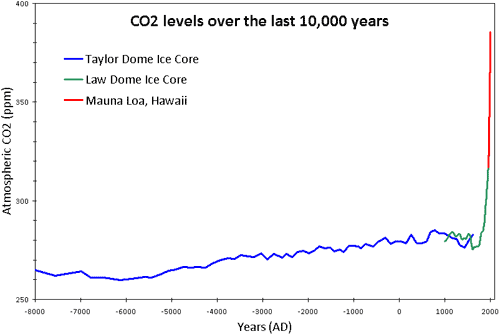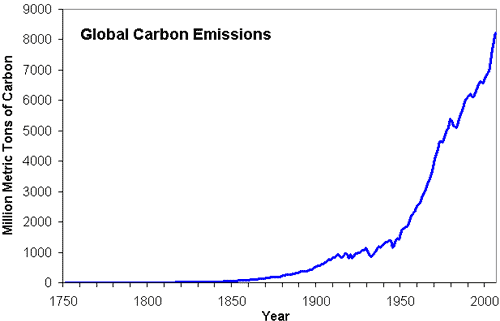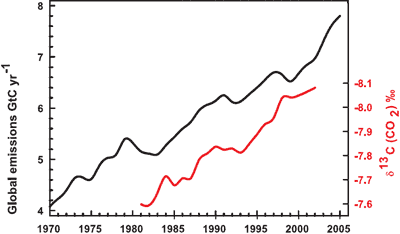Are humans too insignificant to affect global climate?
Posted on 6 October 2009 by John Cook
Are humans too insignificant to affect global climate? After all, our planet is a big place. Isn't it arrogant to claim puny little humans could make a dent in such a huge climate? However, whether human activity might affect climate is not a question of arrogance. It's merely a question of numbers. In particular, there are two numbers to consider.
Atmospheric CO2 is rising by 15 Gigatonnes per year
The first on-site continuous measurements of atmospheric CO2 were implemented by Charles Keeling in 1958 at Mauna Loa, Hawaii. This station provides the longest continuous record of atmospheric CO2. Currently, atmospheric CO2 levels are being measured at hundreds of monitoring stations across the globe. For periods before 1958, levels of atmospheric CO2 are determined from analyses of air bubbles trapped in polar ice cores.
What we observe is that in pre-industrial times over the last 10,000 years, CO2 was relatively stable at around 275 to 285 ppm. Over the last 250 years, atmospheric CO2 levels have increased by about 100ppm. Currently, the amount of CO2 in the atmosphere is increasing by 15 gigatonnes every year.

Figure 1: CO2 levels (parts per million) over the past 10,000 years. Blue line derived from ice cores obtained at Taylor Dome, Antarctica (NOAA). Green line derived from ice cores obtained at Law Dome, East Antarctica (CDIAC). Red line from direct measurements at Mauna Loa, Hawaii (NOAA).
Humans are emitting 26 Gigatonnes of CO2 per year
Global CO2 emissions are derived from international energy statistics, tabulating coal, brown coal, peat, and crude oil production by nation and year. This means we can calculate how much CO2 we're emitting not only in recent years, using United Nations data, but also estimate fossil fuel CO2 emissions back to 1751 using historical energy statistics. What we've found is fossil fuel and cement emissions have continued to increase, climbing to the current rate of 26 Gigatonnes of CO2 per year.

Figure 2: Total Global Carbon Emission Estimates, 1750 to 2006 (CDIAC).
In other words, humans are emitting nearly twice as much CO2 than what ends up staying there. Nature is reducing our impact on climate by absorbing a large chunk of our CO2 emissions. The amount of human CO2 left in the air, called the "airborne fraction", has hovered around 55% since 1958.
Detecting the human signature in atmospheric CO2
Further confirmation that rising CO2 levels are due to human activity come by analysing the types of CO2 found in the air. The carbon atom has several different isotopes (eg - different number of neutrons). Carbon 12 has 6 neutrons, carbon 13 has 7 neutrons. Plants have a lower C13/C12 ratio than in the atmosphere. If rising atmospheric CO2 comes fossil fuels, the C13/C12 should be falling. Indeed this is what is occuring (Ghosh 2003) and the trend correlates with the trend in global emissions.

Figure 3: Annual global CO2 emissions from fossil fuel burning and cement manufacture in GtC yr–1 (black), annual averages of the 13C/12C ratio measured in atmospheric CO2 at Mauna Loa from 1981 to 2002 (red). (IPCC AR4)
So we see that humans have indeed changed the composition of our climate in dramatic ways. If anyone could be accused of arrogance, you might say it's more arrogant to think we can pollute without consequences.
UPDATE: Many thanks to Lou Grinzo from The Cost of Energy who reminds me that the 26 Gigatonnes of CO2 that we're throwing into the atmosphere is based on 2003 data (taken from the IPCC AR4). The latest data from the EIA has human CO2 emissions at 29 Gigatonnes per year.































 Arguments
Arguments






























Bit early to tell whether there is a long term trend there.